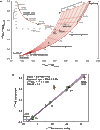Two billion years of magmatism recorded from a single Mars meteorite ejection site
- PMID: 28164153
- PMCID: PMC5287701
- DOI: 10.1126/sciadv.1600922
Two billion years of magmatism recorded from a single Mars meteorite ejection site
Abstract
The timing and nature of igneous activity recorded at a single Mars ejection site can be determined from the isotope analyses of Martian meteorites. Northwest Africa (NWA) 7635 has an Sm-Nd crystallization age of 2.403 ± 0.140 billion years, and isotope data indicate that it is derived from an incompatible trace element-depleted mantle source similar to that which produced a geochemically distinct group of 327- to 574-million-year-old "depleted" shergottites. Cosmogenic nuclide data demonstrate that NWA 7635 was ejected from Mars 1.1 million years ago (Ma), as were at least 10 other depleted shergottites. The shared ejection age is consistent with a common ejection site for these meteorites. The spatial association of 327- to 2403-Ma depleted shergottites indicates >2 billion years of magmatism from a long-lived and geochemically distinct volcanic center near the ejection site.
Keywords: Early Amazonian Magmatism; Mars Geochemistry; Martian Mantle; Martian Meteorite.
Figures




References
-
- H. Y. McSween Jr., A. H. Treiman, in Planetary Materials, vol. 36 of Reviews in Mineralogy and Geochemistry, J. J. Papike, Ed. (Mineralogical Society of America, 1998), chap. 6.
-
- Borg L. E., Draper D. S., A petrogenetic model for the origin and compositional variation of the martian basaltic meteorites. Meteorit. Planet. Sci. 38, 1713–1731 (2003).
-
- Debaille V., Brandon A. D., Yin Q. Z., Jacobsen B., Coupled 142Nd–143Nd evidence for a protracted magma ocean in Mars. Nature 450, 525–528 (2007). - PubMed
-
- Melosh H. J., Impact ejection, spallation, and the origin of meteorites. Icarus 59, 234–260 (1984).
-
- Head J. N., Melosh H. J., Launch velocity distribution of the martian clan meteorites. Lunar Planet. Sci. Conf. XXXI, A1937 (2000).
LinkOut - more resources
Full Text Sources
Other Literature Sources
Miscellaneous

